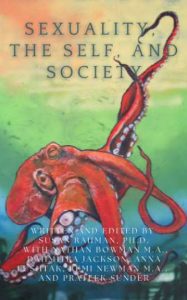[Psychology] Sexuality, the Self, and Society
Description of the Resource:
The content included in Sexuality, the Self, and Society textbook is aligned with the typical scope for an introductory, interdisciplinary Human Sexuality textbook. It is written to be a complete text for a semester length course but could be used, in part, reorganized, or edited in true OER fashion. It is meant to be accessible, relevant, and inclusive. It also will not remain static meaning that the author will continue to update periodically and those who adopt may do so as they see fit.
This textbook offers a comprehensive overview of human sexuality, addressing key topics from various perspectives. It begins by defining human sexuality and exploring sexual attitudes, practices, and the importance of studying sexuality both globally and within the United States. The text then covers research methods, ethical considerations, and historical figures in sexuality research. It delves into the development and anatomy of the human reproductive system, sexual arousal, response, and pleasure, and examines gender identity, roles, and the differentiation between sex and gender.
The text also explores sexual orientation, identity formation, and social movements related to LGBTQIA+ issues. It addresses bias and discrimination in sexuality, attraction, love, and relationship formation, as well as communication and sexual behavior. Comprehensive sections on conception, pregnancy, childbirth, and sexuality across the lifespan provide practical information on these vital topics. Discussions on contraception, abortion, STIs, sexual health, consent, coercion, and sexual violence further enrich the content. Each chapter is supplemented with discussion questions, additional resources, glossaries, and references, making this textbook an invaluable resource for understanding the complex and multifaceted nature of human sexuality.
How This Resource Integrates Diversity, Equity, and Inclusion Principles and Practices:
This textbook integrates diversity, equity, and inclusion principles by examining human sexuality through a global and culturally diverse lens. It explores sexual attitudes, practices, and historical contributions from various perspectives, emphasizing the importance of understanding and respecting diverse gender identities and sexual orientations. The text also explores social construction of heterosexuality, bias, and discrimination, promoting equity and justice for marginalized groups. Practical information on contraception, abortion, and STIs is presented with sensitivity to diverse needs, and discussions on sexual health, consent, and violence underscore the importance of creating safe, inclusive environments. Each chapter’s discussion questions and resources further encourage critical thinking and ongoing learning about DEI in human sexuality.
Testimonials and/or Reviews:
“This book covers an extensive amount of information on sexuality and its development in ourselves and culturally. The chapters are laid out in a way that makes sense as a reader, and also has smaller subheadings to help readers find information. I also appreciated the hyperlinks throughout the text that gave additional resources. I appreciated the authors comment in the About the Book section which states this book is meant to be accessible, relevant, and inclusive. It also will not remain static meaning that the author will continue to update periodically and those who adopt may do so as they see fit.”
“This text has up to date information, which is essential in this topic, as research is catching up to the many years in our society where gender and sexuality was considered binary and static. I appreciated the many places in this text that addressed the history of sexuality. It was mentioned throughout the book and gave introductory information on important events, research, people, and places in history.”
-MaKenzie Johnson, Senior Lecturer, University of Wisconsin – Superior
“Overall a great starting point for a text for my purposes. All educators in this field have different areas they highlight, find important, or are relevant for their audience. The information is presented in a way that is very easy to connect to you and has some great additional resources for those utilizing it.”
– Emily Forsyth, Associate Professor, Minnesota State University, Mankato
Tips, Tricks, and Advice from the Faculty Author(s) Regarding OER Creation:
Check out OEG Voices 053: People and OER Projects from CC ECHO to hear about the author’s experience creating this OER and more!

